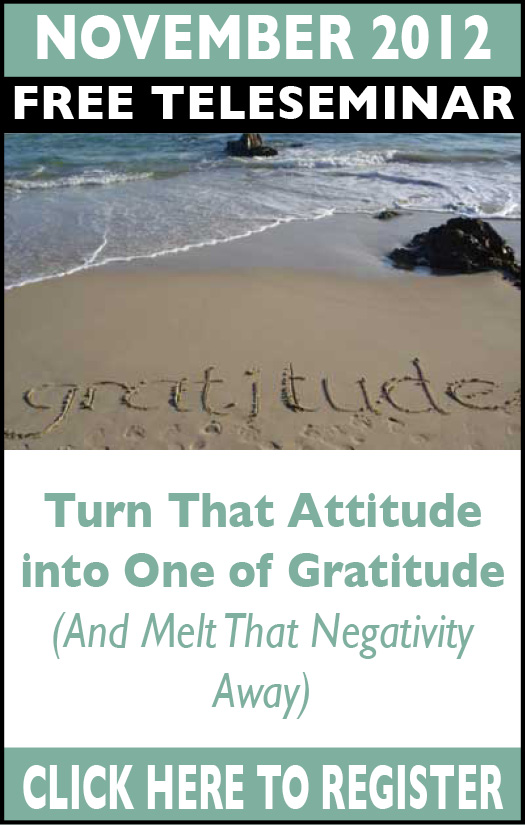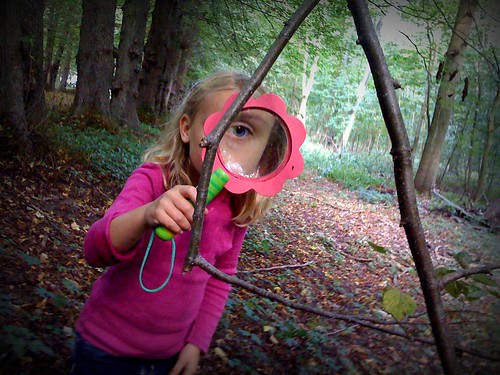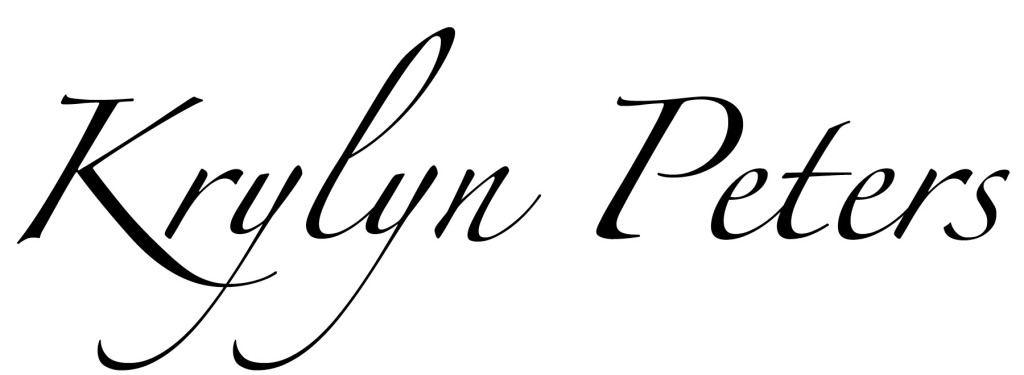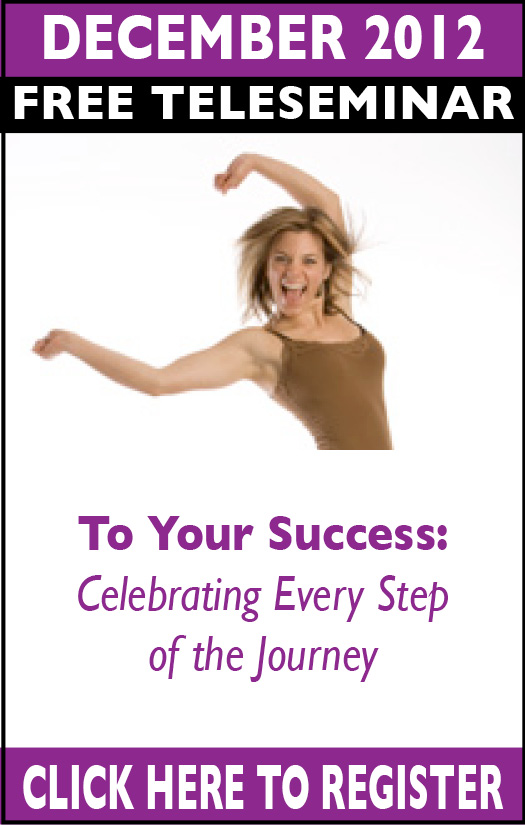Category Archives for Relieving Stress
Celebrate Every Step of the Journey
Welcome to the end of yet another year! Are you where you thought you would be? Most of the time, unless we have a very clearly defined goal, with action steps and deadlines, and a true finish line, we end up a little off the mark. But that’s no reason to get down on ourselves.
We sometimes get so caught up in what we DIDN’T accomplish that we forget to look at what DID get done. The truth is progress is a journey of steady steps forward, mixed with a few steps back. But chances are you’ve moved forward a lot more than backward but get focused on the backward motion, forgetting to enjoy how far you’ve come.
If you’re ready to celebrate the journey and take a good look at what successes you have had (and trust me, you’ve had several), please join me for the December FREE Teleseminar…“To Your Success: Celebrating Every Step of the Journey.” In this teleseminar, I’ll cover:
- What Life and the Two-Step Have in Common
- Why We Don’t Like Celebrating
- How NOT Celebrating is Hazardous to Our Overall Health
- How to Toot Your Own Horn (Without Getting On Everyone’s Nerves)
Don’t delay. Sign up today. The live call is coming soon. But don’t worry, if you can’t attend live, you can still sign up and get access to the recording. Simply go to the REGISTRATION page and enter your name and email to get signed up.
Coming to Our Senses: A Presentation by Jon Kabat-Zinn
Jon Kabat-Zinn is a pioneer in bringing Buddhist practices to the western world. Mindfulness practice is becoming more mainstream in the medical and mental health fields. In fact, I am currently being trained in his Mindfulness Based Stress Reduction (MBSR) techniques, finding I’ve already been using many of these techniques with clients for years and now have more to offer. This work is important. It is about awareness, “falling awake” as Kabat-Zinn would say. Be prepared for about an hour-long presentation, so get comfortable and enjoy!
Below is the poem he references in his presentation (at 20:34), which I absolutely adore!
Love After Love by Derek Walcott
The time will come
when, with elation
you will greet yourself arriving
at your own door, in your own mirror
and each will smile at the other’s welcome,
and say, sit here. Eat.
You will love again the stranger who was your self.
Give wine. Give bread. Give back your heart
to itself, to the stranger who has loved you
all your life, whom you ignored
for another, who knows you by heart.
Take down the love letters from the bookshelf,
the photographs, the desperate notes,
peel your own image from the mirror.
Sit. Feast on your life.
How to Steer Life in a More Positive Direction
 You are the driver in your own life, making decisions that affect which way you are headed, how you will get there, and what you will do once you get there. You will encounter road blocks, detours, and hazards, and of course you must deal with the other drivers on the road who might be headed in different directions. People may cut you off, slow down in front of you, honk at you, or otherwise attempt to distract you from your destination.
You are the driver in your own life, making decisions that affect which way you are headed, how you will get there, and what you will do once you get there. You will encounter road blocks, detours, and hazards, and of course you must deal with the other drivers on the road who might be headed in different directions. People may cut you off, slow down in front of you, honk at you, or otherwise attempt to distract you from your destination.
The good news is you are in the driver’s seat of your own life, as scary and unsettling as that may be. Your job, then, is to learn the rules of the road and how to maneuver your vehicle (aka you). Your vehicle will need regular maintenance and TLC to run properly.
Let’s take a closer look at your vehicle.
The Four Wheels
Think of the four wheels (or tires) on a car. In order to get you from point A to point B, you need all four of them to be in relatively good working order. If one becomes flat, your car will wobble and you may lose control. When looking how the wheels on a car relate to life, each has a different function:
- Body Sensations: This wheel is about information. Our bodies are constantly giving us information in the form of signals. A growly tummy means we’re hungry. A yawn means we’re tired or our brain needs more oxygen. A pain means something hurts and we need to adjust. And so on. Pay attention to your body and make any necessary adjustments. Eat when you are hungry. Drink when you are thirsty. Sleep when you are tired. You get the idea. But so many of us ignore these little signals or try to push through them because we’re too busy or we’re simply not paying attention.
- Thinking: This wheel has to do with not only what thoughts we have but also how we think overall. Our thoughts can include what we think about ourselves, others, and the world around us. They can be positive, negative, or neutral. They are reflected in the words we say. How we think is more about the patterns we adopt, such as thinking things are right or wrong (black and white thinking), or that others should know what we’re thinking (mind-reading), or that the worst will always happen (catastrophizing). What and how we think affects how we live our lives, what roads we take, how we drive, and where we end up.
- Feeling: This wheel is about the emotions we feel. Sadness, anger, pain, hurt, happiness, joy, frustration, and the list goes on. Many of us try to mask our feelings, pretending they don’t exist, denying them, or sweeping them under the rug. Feelings, however, are just signals. We tend to assign them as positive or negative based on what we associate with them. For example, if your experience of anger includes tension or pain in your body and/or negative thoughts about yourself, you will likely believe that anger is a negative emotion. Most of us believe that. But anger in and of itself is just a sign that something isn’t balanced and adjustments must be made in order to get back to balance.
- Doing: This wheel is all about our actions, what we do, how we react, how we behave. This is what not only we can see but what others can see. It is measureable, observable. And despite popular belief, we do have control over what we do. It is about making choices that are either consistent or inconsistent with who we are and where we are going. We get in trouble when we make a choice and we’re not happy with the consquences, so we tend to want to blame others or circumstances rather than take full responsibility.
As you may have guessed, all four wheels serve an important role in our lives, but they do not operate independent of one another. Thinking affects our feelings. Feelings affect our actions. Actions affect our body sensations. Each wheel is affected by all the others, which is absolutely wonderful news. It means that even a small change in one area will affect the other areas.
So if you aren’t exactly thrilled with where your life is headed right now, think about what one area you can change. Here are some tips to try:
- Instead of thinking that the worst is always going to happen, remind yourself of all the good things that have happened in your life. We tend to focus only on the negative, but truth be told, most of the bad things we think will happen never come true.
- Get some sleep. One of the biggest areas we neglect is sleep. We stay up late and get up early trying to squeak out every possible moment to get things done (or obsess about getting things done and not actually do them). Our bodies (and brains) need rest.
- Honor your feelings. Feelings come and go. They are natural. We tend to think that “negative” feelings will last forever, especially really intense ones. But it is impossible to sustain a high-intensity emotion forever. There is a natural flow to feelings. A beginning, leading up to a peak, then coming back down. Think of a bell curve. Allow your feelings to be expressed and you will soon realize life looks a bit more rosy on the other side.
For more tips on HOW to drive your life toward a more positive direction, please join me for my next monthly FREE Telseminar, “Turn That Attitude Into One of Gratitude (And Melt That Negativity Away).” Simply go to the REGISTRATION page at https://krylyn.com/dev/free-teleseminars/turn-that-atittude, and enter your name and email to get signed up. Even if you can’t attend the live call, you will get access to the recording of the call, but only if you register.
Photo: Car N Motion © by TheBusyBrain
How to Switch Off the Negative and Switch On the Positive
 Think about what you think about most of the time. Does your inner dialogue consist of criticism (of yourself or others), negativity, judgments, what-if’s, shoulds, etc.? Or does that inner voice say much kinder, gentler words of encouragement, support, and positivity? My best guess is that we’ve heard it all, but we tend to listen to the harsher side more often.
Think about what you think about most of the time. Does your inner dialogue consist of criticism (of yourself or others), negativity, judgments, what-if’s, shoulds, etc.? Or does that inner voice say much kinder, gentler words of encouragement, support, and positivity? My best guess is that we’ve heard it all, but we tend to listen to the harsher side more often.
When we’re born, we are a clean slate of possibilities, love, and non-judgment. As we get older and are exposed to various environments, other people’s perspectives, and experiences, our perspective changes. We adopt filters through which we see the world. There’s as many kind of filters as there are thoughts and feelings, but the two most basic ones are: Negative and Positive.
Using a negative filter, our perspective is always a bit tainted. We are critical of ourselves, which means we’re also critical of others. We may see the world as a big scary place and have difficulty trusting not only others but ourselves. Our life experiences have taught us that we are not safe, at least not completely, and that it is necessary to have our guards up. Our inner thoughts reflect our inner turmoil, and our behaviors are in line with this overall negativity too.
With a positive filter, our perspective is also a bit tainted. However, we are able to see the good in ourselves and others, and realize the positive side of most situations. When life throws a curve ball, we are able to quickly adapt and alter our thoughts and actions accordingly. Our inner thoughts reflect our belief that everything’s going to be okay. And we are able to make decisions from a more centered place.
One big difference between using a negative and positive filter is in what we look for. I’m a strong believer in that we can find evidence to support anything we want. If we are looking for the negative, we’ll find it…and a lot of it. But contrary to what we think, when we find the negative, we’re not more likely to turn it around. We’re actually just fueling a fire of justification, of being right, and saying “see, I told you life couldn’t be trusted.” And when we’re in that place, we tend to stay there.
If we are looking for the positive, we’ll also find that…and a lot of it. We can see that other people’s actions are about them, not us. We understand we may not have control over what happens around us, but we do have control over how we respond.
The good news is that you can choose to switch your filter from negative to positive at anytime. It’s really just about a shift in your attitude. Here’s some tips on how to make that shift:
- When you feel negativity creeping in, stop and take a deep breath. Say something completely contrary to what you are thinking. For example, if you think this is the worst situation you’ve ever experienced, tell yourself “I am so fortunate that this is all that is happening. Things could be worse. And I am strong enough to handle this.”
- Remind yourself of what you have to be thankful for. Make a list of all the wonderful things you have going for you. Keep this list with you at all time and refer to it when that negative filter rears its head.
- Make a preemptive strike. Before negativity even has a chance to surface, say something positive to yourself. You might start your day by using positive statemtns such as “I am confident,” I am strong,” “I am safe,” “I can handle any situation with grace and ease.”
We can all go to that dark, negative place sometimes. But we don’t have to stay there. Learning (and practicing) ways to switch over to the positive side can be truly beneficial to you in so many ways.
For more tips on HOW to turn that negative attitude around fear, please join me for my next monthly FREE Telseminar, “Turn That Attitude Into One of Gratitude (And Melt That Negativity Away).” Simply go to the REGISTRATION page at https://krylyn.com/dev/free-teleseminars/turn-that-atittude, and enter your name and email to get signed up. Even if you can’t attend the live call, you will get access to the recording of the call, but only if you register.
Photo: Lights! © by TheGiantVermin
Turn That Attitude Into One of Gratitude
 Do the terms “Debbie Downer” or “Negative Nelly” describe you a little too well these days? Life has its ups and downs for sure. But sometimes we can get stuck in the down swing, only seeing the negative side of things.
Do the terms “Debbie Downer” or “Negative Nelly” describe you a little too well these days? Life has its ups and downs for sure. But sometimes we can get stuck in the down swing, only seeing the negative side of things.
We can get so focused on what we don’t have, what we don’t like, and what we can’t quite seem to grasp. And when we’re so focused on all that stuff, there’s not room for much else, like what IS working well (and there’s ALWAYS something that is working).
If you’re ready to turn that negativity upside down, please join me for the November FREE Teleseminar…“Turn That Attitude into One of Gratitude (and Melt That Negativity Away).”
In this teleseminar, I’ll cover:
- Why Attitude Really is Everything
- What Drives Your Attitude
- How to Turn Negativity Upside Down
Don’t delay. Sign up today. The live call is coming soon. But don’t worry, if you can’t attend live, you can still sign up and get access to the recording. Simply go to the REGISTRATION page and enter your name and email to get signed up.
Focusing on What Works
 Do you often struggle in one or more areas of your life? Finances, health, relationships, work, etc.? It seems like the areas in which we find challenges are ones we focus on, which only makes sense if you believe, like many of us seem to, that you must fix what is broken. Society bombards us with messages of improving those areas. We must listen, because the messages keep coming.
Do you often struggle in one or more areas of your life? Finances, health, relationships, work, etc.? It seems like the areas in which we find challenges are ones we focus on, which only makes sense if you believe, like many of us seem to, that you must fix what is broken. Society bombards us with messages of improving those areas. We must listen, because the messages keep coming.
But how much time do we spend focusing on the areas that ARE working well? If you’re anything like me, I’m guessing you don’t focus much on those at all. Yet, if we’re breathing (and reading this), we must be doing something right.
It’s all a matter of perspective.
And to take it another step further, what if you could learn to love the part of you that isn’t “perfect” or the challenge you are facing. I’m not talking doe-eyed, weak-in-the-knees kind of love, but an acceptance of what is.
I began this practice after reading the book “Learning to Love Yourself: A Guide to Becoming Centered” by Gay Hendricks a few years ago. In it, he talks about consciously accepting the parts of yourself that you struggle with. Saying outloud the phrase “I love that part of me that…” is a cornerstone to this practice. For example, when I struggle with feeling overwhelmed about a deadline, I might say to myself “I love the part of me that has difficulty staying focused” or “I love the part of me that would rather be writing a song.” Inevitably, I end up with a smile on my face or a sense of relief, because just stopping and saying something that seems so contrary to what I’m thinking or experiencing gives me persmission to be more gentle with myself and shifts my perspective. And, it’s all a matter of perspective.
So what are you doing that is working for you? Do you take time to recognize those things, or just gloss over them, sometimes unconsciously, on your way to thoughts of what isn’t working well? Take some time to focus on what is working and shift your perspective. Here’s some tips to try:
- Write a list of things that are working well for you. Things that are working well are not areas that require a lot from you. They are things that happen on auto-pilot and can be as simple as taking five minutes in the morning to stretch, taking a walk around the block, or brushing your teeth before bed. Keep this list with you and add to it as you think of more. Look at it when you are having one of those “nothing is working well” moments.
- Pick one thing from your “things that are working well” list and DO MORE OF IT.
- Think of one area in your life that you would like to change. Be specific. For example, one of my areas to work on is doing one thing at a time (which I call “mono-tasking”). That’s pretty easy to measure. I’m either doing one thing at a time or I’m not. Then, say “I love the part of me that…” and fill in the rest with the area you are focusing on. For me, I might say “I love the part of me that has difficulty focusing on one thing at a time.” Say your phrase out loud five times. Notice how you feel after saying it.
Remember, it may seem easier to focus on the problems, but doing so just gives the problems more energy, which I’m guessing is NOT what you want to do. Switching your focus to what is working and accepting when you are challenged by it is a much gentler way of being, which I’m guessing is more of what you DO want.
I’d love to hear what results you get from shifting your focus. Leave a comment below.
Photo: Curious kid © by Mads Boedker

